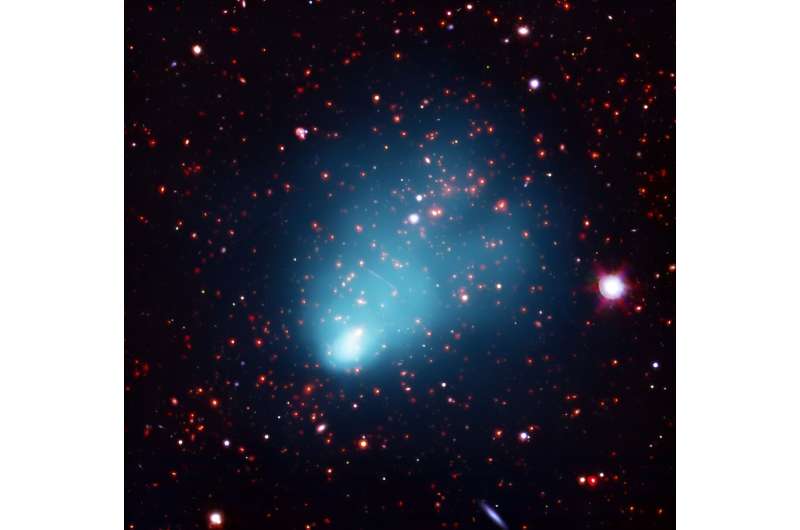This article has been reviewed according to Science X's editorial process and policies. Editors have highlighted the following attributes while ensuring the content's credibility:
fact-checked
peer-reviewed publication
trusted source
proofread
Titanic galaxy cluster collision in the early universe challenges standard cosmology

A collision of two massive clusters of galaxies when the universe was half its current age should not have happened according to the standard theory of cosmology, says a new study by an international group of astronomers, including a physicist at the University of St Andrews.
According to the Lambda-cold dark matter (ΛCDM) standard model of cosmology, galaxies form first and only later combine into larger clusters of galaxies. Thus, galaxy clusters should take a lot of time to appear on the cosmic scene. The new study, published in The Astrophysical Journal, challenges this by showing that two extremely large galaxy clusters collided at a very high speed when the universe was only about half its current age.
The cluster pair in question is known as El Gordo—which means "The Fat One" in Spanish—an apt name given its mass is about 2,000 trillion times that of the sun (2 followed by fifteen zeroes). The new study uses an updated estimate of its mass that is much more precise. This removes a major source of uncertainty in an earlier study by the same authors about just how problematic El Gordo is for ΛCDM.
The mass was estimated using the deflection of light from background galaxies, whose shape appears distorted thanks to the gravitational pull from El Gordo—a bit like a magnifying glass. This "weak lensing" mass was obtained using the Hubble Space Telescope, but agrees with more recent results from the James Webb Space Telescope and other studies using other methods. The mass now has a modest 10% uncertainty.
The research, led by Elena Asencio, a Ph.D. student at the University of Bonn, used previously published detailed simulations of the interaction to estimate the speed at which the clusters collided. The authors then searched through a less detailed cosmological ΛCDM simulation covering a very large volume to look for simulated cluster pairs.
The aim was to count how many of these are broadly analogous to what El Gordo was like shortly before the collision. This was done with an innovative "lightcone tomography" method which considers that more distant objects are viewed further back in time, when there was less structure.
The results revealed that the tension with ΛCDM is very severe for any plausible collision velocity. Moreover, the remaining uncertainty in El Gordo's mass no longer plays a significant role.
Elena said, "The results of our previous study were questioned by some scientists once an updated mass estimate for El Gordo was published and came in slightly lower. This does reduce the tension with ΛCDM, but it is still highly significant for any plausible collision velocity. Hundreds of detailed simulations show that El Gordo cannot look like the photos with a much slower collision velocity that could plausibly arise in ΛCDM."
While it is possible to get a simulation that looks like El Gordo with a more rapid collision, such an event is too rare in ΛCDM. This is because it would be very unusual to find two such massive clusters within striking distance at such an early stage in cosmic history. Further requiring them to be headed towards each other at a high speed stretches credibility. The new study and the more precise mass measurement may lead to more efforts to simulate El Gordo to better understand this enigmatic object.
El Gordo is not the only example of a cluster collision at odds with ΛCDM. Dr. Indranil Banik of the School of Physics and Astronomy at St Andrews, who developed the statistical analysis used in this project, said, "The Bullet Cluster is another example of a highly energetic collision between two galaxy clusters, albeit at a later epoch. Taken in combination with El Gordo, the situation becomes even worse for ΛCDM. And several other examples are known and mentioned in our study."
There are also several studies showing that individual galaxies seem to form much more rapidly than expected in ΛCDM, largely thanks to very recent James Webb data. Of the broader context of the El Gordo results, Pavel Kroupa, Professor at the University of Bonn and Charles University in Prague, said, "There is now a lot of evidence that structure formation in the universe occurred faster than expected in ΛCDM. We are currently exploring other lines of evidence for this."
More information: Elena Asencio et al, The El Gordo Galaxy Cluster Challenges ΛCDM for Any Plausible Collision Velocity, The Astrophysical Journal (2023). DOI: 10.3847/1538-4357/ace62a
Journal information: Astrophysical Journal
Provided by University of St Andrews



















